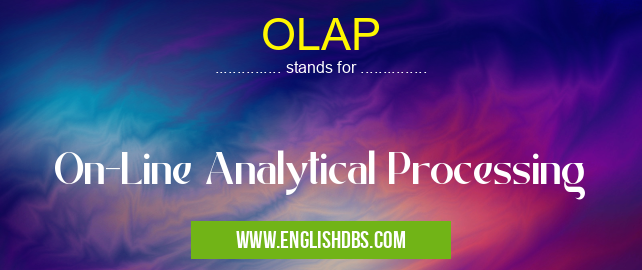What does OLAP mean in SOFTWARE
On-Line Analytical Processing (OLAP) is a technology to store and analyze data in order to identify patterns and trends. It helps businesses make informed decisions, faster. OLAP helps to detect hidden relationships between facts in large datasets by applying multidimensional analysis. With OLAP, businesses can query data quickly and accurately, creating powerful visualizations such as pivot tables and cubes. By providing easy access and intuitive analysis of large datasets, OLAP offers new ways to view complex information for better decision-making and business insights.

OLAP meaning in Software in Computing
OLAP mostly used in an acronym Software in Category Computing that means On-Line Analytical Processing
Shorthand: OLAP,
Full Form: On-Line Analytical Processing
For more information of "On-Line Analytical Processing", see the section below.
What is OLAP?
OLAP stands for On-Line Analytical Processing. It is a form of business intelligence that enables computer processing of large amounts of data from multiple sources in order to provide fast analysis. It allows users to easily manipulate multi-dimensional data, helping them gain valuable insights into their business operations from different angles. This type of data analysis requires the use of specialized software tools designed specifically for this purpose.
Using OLAP, businesses can gain insight into customer behaviour over time, understand product performance or identify areas where they need improvement more efficiently than traditional methods like manual spreadsheets or paper reports. Through the use of databases and SQL queries, users can perform complex calculations on massive datasets with ease and generate comprehensive analytics reports for better decision making.
Benefits of using OLAP
One key benefit of using OLAP is its ability to handle huge volumes of data efficiently with minimal hardware requirements while still producing detailed analytical results quickly. Its flexible query capabilities allow users to ask complex questions about their data without needing to write intricate programming code or build complex spreadsheets manually – instead they can simply define the results they want in plain language via an easy-to-use graphical interface. Additionally, OLAP technology provides features like drill down analysis which make it easier for non-tech savvy business people to quickly gain understanding from insights found in the vast amount of available data points available today from their customers or market research studies.
Furthermore, using an OLAP system ensures that any changes implemented do not affect other parts since all components are kept in separate schemas or cubes which remain unaffected if modifications are made elsewhere – thus removing any risks associated with mistakes or errors that could have been made when handling large amounts ofdata manually via databases or spreadsheets. Finally, since there is no need for external developers concerns about deploying updates regularly reduces significantly as well since these systems are very user friendly allowing administrators quick updates without needing help from outside resources when needed most such as during peak season periods etc.
Essential Questions and Answers on On-Line Analytical Processing in "COMPUTING»SOFTWARE"
What is OLAP?
OLAP stands for On-line Analytical Processing and is an advanced form of data management which provides fast, efficient analysis of large query sets from multidimensional databases. It enables users to quickly and easily explore complex data structures, identify trends and relationships, and develop predictive insights with greater accuracy.
What are some of the benefits of using OLAP?
Using OLAP allows businesses to quickly mine data for insights into their operations. This can range from improving customer segmentation to enabling faster decision making. Additionally, OLAP enables users to respond more quickly to changes in the market while reducing costs through improved operational efficiency.
What type of data is suitable for use with OLAP?
Typically, structured data such as financial records or inventory levels work best with OLAP technology. This information must be stored in a dimensional database prior to using it as part of an analytical processing system.
How does a user interact with an OLAP system?
Users typically use familiar drag-and-drop functions as well as other features provided by modern dashboard software solutions that allow them to visualize the output generated by the analytic results. In addition, many users employ natural language queries in order to speed up their task completion times.
How secure is an OLAP system?
Companies operating sophisticated analytical systems often employ security protocols such as encryption in order to protect confidential information contained within the system from unauthorized access. Additionally, many systems will incorporate role-based authentication controls that limit user access based on their specific permissions levels.
Is there any limitation when using an OLAP system?
While there are many benefits associated with utilizing an OLAP platform, certain limitations still exist in terms of scalability. Allowing multiple concurrent users often requires powerful hardware resources which may not be available at smaller organizations or those lacking sufficient IT infrastructure.
Does the size of a business impact the usefulness of aOLAP system?
The size or scope of a business does not necessarily impact its ability to take advantage of this type of technology; however, larger organizations might benefit more since they are likely able to dedicate additional time and resources towards their analytics initiatives.
